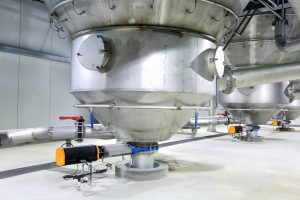
Material bridging in a hopper can slow down production and reduce bulk storage space. The stagnant material can spoil or become contaminated, and workers have to clear the vessel and throw out compromised batches.
What is material bridging?
Bridging is the material block that forms above the discharge outlet of a hopper, silo, or any bulk material handling equipment.
The bridge is caused by friction on the vessel walls which slows down the flow of material. Eventually, the material particles start to bind and interlock, until it partially or completely blocks the discharge outlet.
The bridge is so strong that it can support the weight of material above it. New material can condense the trapped material further and strengthen the bonds.
Types of material bridging
- Mechanical bridging. Particles mechanically interlock, like jigsaw puzzles. This usually happens for particles that are larger than 3mm.
- Cohesive bridging. Particles compress until they bind together. This usually happens for smaller particles, especially those that attract moisture.
What causes material bridging in the hopper?
Material bridging can be caused by the hopper design, the material’s flow properties, and the conditions in the plant.
Hopper Design
Ideally, the hopper design should reduce friction and encourage flow. However, there is no one-size-fits-all solution. Solids and liquids behave differently, and materials have unique properties that can also vary in different conditions. These factors have to be considered while choosing the hopper’s angle, and the outlet’s shape and diameter.
Material Properties
Some materials are simply more prone to bridging and arching. This includes:
- Moist and sticky materials
- Materials that tend to settle during storage
- Materials with a high cohesive strength
- Hygroscopic powders that attract moisture
- Pellets that soften and form soft clumps
- Fibers that can entangle
- Irregular particles that can interlock
- Heavy materials that can push down on stagnant material and cause it to compress
Plant Conditions
Fluctuating temperatures can affect the stress on the hopper walls and the material flow properties. Moisture in the air can cause materials to expand and compress. Gas in the air can also permeate through powders and fill empty spaces.
The best solution for material bridging in the hopper
Flow aids solve bridging and other material blocks by breaking up the cohesive bonds in the material. However, not all flow aids can do this safely or effectively.
Manual cleaning—where workers hammer the vessel or enter the hopper to clear the build-up with axes and shovels—is slow and dangerous. Some materials release flammable or toxic gases during storage. Workers are also at risk for falls, sprains, health problems from direct exposure to the material, or being hit by falling material.
Vibrators can damage the vessel and can cause some materials to become more compact. Fluidizers can only activate light powders; air cannons are expensive and still leave material residue on walls.
AirSweep is the most cost-effective solution for material bridging in hoppers. It releases powerful air pulses that break up bridging and sweep stagnant material back into the flow stream.
AirSweep engineers customize the system so the units are installed at key areas on the hopper to stimulate first-in/first-out flow. They select the right model for the material and the vessel size. The AirSweep USDA-accepted model is also specially designed for sanitary applications like food, beverage, and pharmaceuticals.
The AirSweep system is energy-efficient. It uses less air than air cannons, and the units pulse in sequence instead of running continuously like vibrators and fluidizers. The units also have a large area of activation and move more material with every pulse.
Find more information about AirSweep, or get a customized quote.





Comments are closed